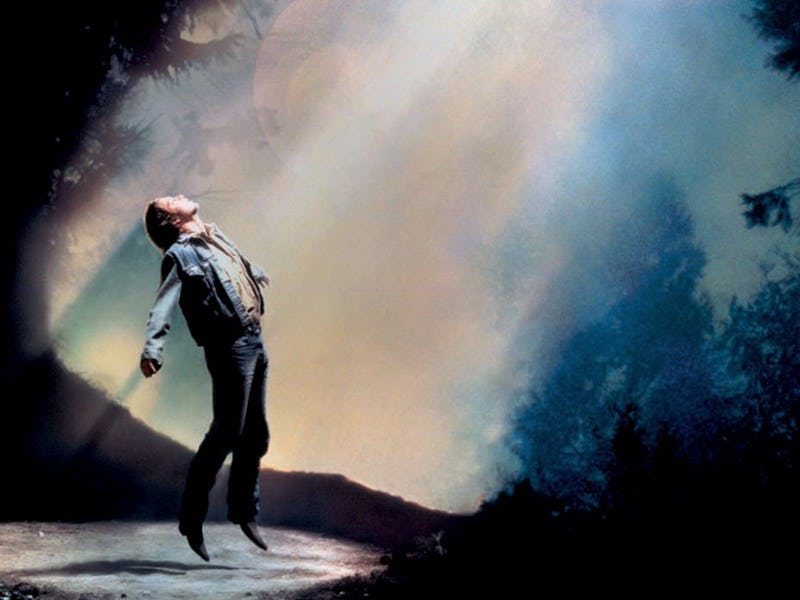You need to watch the most realistic alien sci-fi movie on Amazon Prime ASAP
Seeing is believing in this 1993 science fiction mystery.

Incandescent light shimmers through the trees that carve out a country lane. It creeps towards us, threatening to thunder over the horizon. The score builds in menace. We know not what this sinister form bodes, but the wind howls perilously. It breaks over the road, forming a shape: headlights. A rusting and battered pickup truck races towards us, erratic in direction and skidding around as if a fawn on ice.
A day later. Five men, salt-of-the-earth loggers from the gruff little community of Snowflake, Arizona, have come home spouting a seemingly tall tale. Not only is their friend and colleague Travis Walton missing, but he was also zapped by a fireball hanging ominously in the sky. Presuming him to be dead, they fled back to town. No one believes them; what’s more, the word on the lips of the federal lawman is “homicide,” a conspiracy in which they’re all embroiled. But their lie detectors come back negative, and some days later, Travis is found naked and sniveling miles from where he disappeared.
These are allegedly true events that occurred in Snowflake in November 1975. And just under two decades later, filmmaker Robert Lieberman set out to dramatize it for an American audience enraptured by stories of alien abductions from the mid-40s onwards. The result is 1993’s Fire in the Sky, which is now streaming on Amazon Prime Video.
There have been many films that have tackled the spooky urban mythology of alien abductions. Recently, Milla Jovovich starred in the stirring The Fourth Kind, a formally audacious albeit tonally messy movie that imbues one fictional tale with a dose of docurealism. Alien Abduction, a low rent B-movie, put a found footage spin on the subject with varying results. The Vast of Night is the best contemporary take, evoking the filmmaking sensibilities of its ‘50s setting in aid of its unnerving, engrossing mood.
The heyday was inarguably the late ‘80s and early ‘90s. Just before Fire in the Sky in 1993 came a compelling piece of sci-fi horror that was also, ostensibly, inspired by real events. Communion, released in 1989 and based on Whitley Strieber’s memoir (fittingly subtitled A True Story), starred Christopher Walken as a family man whose life is changed after an encounter in the remote wilderness. Like Fire in the Sky, it focuses more on the domestic impact of such an out-of-this-world occurrence than it exploitatively summons unearned, visceral horror and to great effect.
D.B. Sweeney stars in Fire in the Sky.
The horror and suspense are, too, some of the great strengths of Lieberman’s direction. Divorced of a prologue that invokes the tropes of “fourth kind cinema” - missing time, an implausible encounter, ominous lights in the sky - this could well be a strong crime thriller in itself.
While we’re always aware of the innocence of the men at the mystery’s center, their lives remain in the balance. The arrogance of the lawman at the forefront of the investigation subverts the usual heroism of such a figure. James Garner’s typically no-nonsense sheriff archetype has a prosecution record that precedes him, but we still sympathize with his frustrations because the abduction story is mind-boggling.
Fire in the Sky also stands as a compelling take on ‘70s, cornfed America in decline from a promised idyll. Snowflake is the epitome of a decaying industrial town: a place where fathers teach their sons a singular trade - in this case, logging - to sustain the local economic lifeblood. It’s a vacuum that few can escape. In this sense, it shares surprising traits with The Last Picture Show, as the portrait of a promise falling apart at the seams. Relatedly, the men in question aren’t just paper-thin devices. They’re full-bodied, with quandaries and flaws; they have mortgages on the line and kids to feed.
Travis Walton (D.B. Sweeney) is abducted by aliens in Fire in the Sky.
But then, of course, there’s the sequence which centrally recounts Travis’ harrowing abduction. Again, most of the familiar tropes are at play: Waking up after a period of stasis, he emerges from a womb-like, organic capsule, floating into a vein-like gravity-less cavern. The production design is terrifically unique, taking on the appearance of a breathing, pulsating cave, intertwined with a circulatory system of innumerous, eerie halls and passages. Everything is covered in goo, and Travis stumbles upon dissected bodies and space suits, the helmet of which evokes the classic “Grey alien” design, with big, black almond-like eyes.
It’s when they finally capture and drag him to the operating table that the visceral gore-factor turns up tenfold. It’s better experienced than described, but the scene, scored by the foreboding, mechanical whirling of medical instruments and Travis’ muffled wails, is tremendously unsettling.
Let’s be honest. Despite the lie detectors and enduring mythos, it’s more than likely the Walton encounter was either a hoax or the result of something more explainable. But nevertheless, Fire in the Sky remains a terrific piece of science fiction.
Fire in the Sky is now streaming on Amazon Prime Video.
This article was originally published on